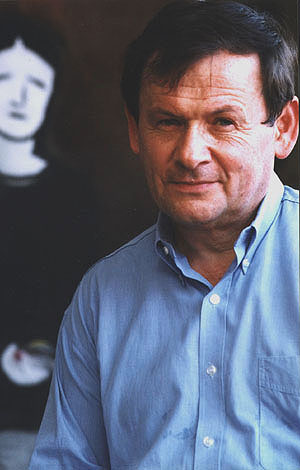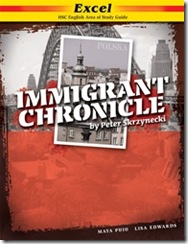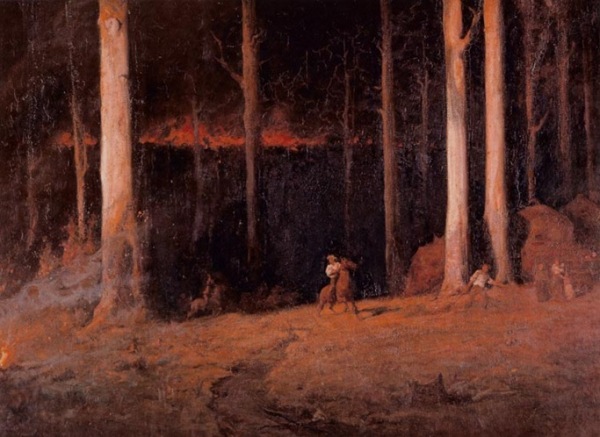Revised March 2008

Peter Skrzynecki (above) must be one of the most popular choices for the Journeys Area of Study in the NSW HSC English courses. I have yet another coachee studying his work right now. There is so much good stuff available online!
The obvious starting point is NSW HSC Online for an overview of this part of the course. Very early in your study you must be clear about what you are doing, because you need to filter all the information available to make sure your efforts are relevant. I recommend also careful examination of past HSC questions and published exam answers to refine that filtering. While looking through HSC Online you may also find some guidance here and in other parts of your course in the annotated resource guide for teachers (but also useful for curious students): Search Site Reviews.
Your next stop might be Peter Skrzynecki’s Web Site.
On this site you will find information about my life which may help you understand some of my poems – especially those set down for study on the New South Wales HSC syllabus.
It contains a background to my family’s migration to Australia in 1949 and a general outline of those influences which led to my writing poetry.
It also contains links to other sites where my work is featured, a list of my publications, a selection of reviews of various publications, poetry and prose, and poems from my most recent collection of verse.
Amelia Illgner wrote a good brief introduction to Peter Skrzynecki: The immigrant experience for the 2004 Sydney Writers’ Festival Schools Program. This is no longer online, but the gist was:
Australian poet Peter Skrzynecki knows about journeys the way other people know about real estate, stock options and the footy ladder. Skrzynecki is a living treatise on the immigrant experience and his poems are charged canons of his observations. They tell of travelling, of belonging and the innate beauty in discovering oneself and rediscovering home and, always, memory…
Here is a more recent poem by Peter Skrzynecki (2005). I rather like it; do you? Where does it fit into the journey stories you already know from the poems set for study? Is it similar/different in style and tone? Would you keep all the poems currently set, or would you substitute this poem for one currently set? If so, which poem would go? Why delete that poem in favour of this one?
WARNING: Do not use another poem by Peter Skrzynecki as a supplementary text.
Summer in the Country
Summer in the country
was brushing away
flies from your face
and wiping sweat from your eyes—
watching grasses and grains
shimmer in paddocks
or sheep and cattle
grazing beyond a windbreak of pines.
Galahs clanged over the homestead.
A windmill turned
when a breeze sprung up.
Cockatoos screeched from the pepper tree.
Only crows frightened me
with their sorrowful cries
and the way they flew slowly
like black crosses.
The old slab-split shed
was a treasure-trove
of harnesses, bridles, farm
machinery, forty-four-gallon drums—
its walls covered
with cobwebs that housed
unimaginable spiders
but where it was cool inside.
I didn’t miss Europe
like my parents did—
nor a Christmas without snow
I’d hear them talking about.
Summer in the country
was being given a glass of cold lemonade
and falling asleep
under a red-gum’s shade.

You will find a forum here where students have contributed some ideas, especially about “Crossing the Red Sea” and on possible supplementary texts. Use it wisely but don’t quote it! [This forum has apparently been hacked. 9 March 2008.]
Peter Skrzynecki (and Michael Gow) were interviewed on ABC 702 in October 2006.
…Richard Glover: All right, Peter, you rat for doing this to our children. “To what extent has studying the concept of physical journey in the work of Peter Skrzynecki expanded your understanding of yourself, of individuals, and of the world?” Now you’re answering the question, what do you say?
Peter Skrzynecki: I say it teaches me about perseverance, it teaches me about tolerance, it teaches me about hope, it teaches me that nothing comes easy without working for it.
Richard Glover: No, no, no, I’m marking you down. You’ve got to say all this in relationship to the concept of physical journey in the work, you’re not relating it to the question, Peter.
Peter Skrzynecki: Because no journey is just physical. I’m sitting here in a doctor’s surgery actually waiting for root canal therapy while I’m talking to you, so I’ve made a physical journey from my home to here, but no journey is just physical, you know, it’s emotional, it’s spiritual, it’s psychological it’s mental. I’m about to have some holes drilled into my tooth…
Richard Glover: Now Peter, do you feel any sympathy for these studying your work?
Peter Skrzynecki: Yes and no. When I said to you earlier, one way or another you’ve got to sit for an exam, whether it’s poetry or whether it’s something else. I feel sympathy for them because at this stage in their lives they’ve really got to be somehow told or shown that life isn’t just about exams, and unfortunately the system, such as it is, puts them into an exam situation, but having taught in schools and at university myself, you somehow look beyond that, and when I talk to students when I lecture, I try and make them think for themselves.
Richard Glover: And the other thing about this discussion is it’s great that among all the classics, and there are lots of classics of things like Mark Twain and Shakespeare’s Tempest and Coleridge, amongst all this there things like Michael’s wonderful play Away and your wonderful poems.
Peter Skrzynecki: The year after the war, I mean we went on a physical journey from Europe to Australia, we lived in migrant camps, hostels, detention centres as they were called. There were no Social Service benefits in those days. If you wanted to get ahead in this country, you had to work, that physical journey was the start of a whole new life. And I learnt from the lives of my parents, and you could look around you to some of the big names in the corporate world today like the Lowys and the Richard Pratts, they came here with nothing virtually.
Richard Glover: And the physical journey reflected.
Peter Skrzynecki: That was just the start of something bigger.
Richard Glover: Well look, you’ve almost made up your marks. I think you’ve got the same mark as Michael now. Very well done.
Peter Skrzynecki: All I can say to the students, ‘Don’t hold it against me’, and I hope you’ve learnt something from the poems.
Richard Glover: Yes, fantastic. Now Peter, thank you very much for talking to me…
He shows some realism about the course there, doesn’t he, and a sense of humour. Let’s face it, while I don’t mind this course the whole thing, from a poet’s point of view, is really quite mad! No poet has ever sat down and said “I think I will write poems about the concept of journey…” At least I don’t think they have. If you are clever, by the way, you will also see you have a real example of the radio interview text type to study there too. Could come in handy…
A few basic questions to ask yourself about every text you encounter in this Area Study:
— What does this text contribute to my understanding of the concept of “the journey”?
— How is the idea of “journey” represented in this text?
— What connections are there between this text and others I have viewed or read?
— What differences are there between this text and others I have viewed or read?
I am sure you and your teachers will think of more!

Migrant camp
See How welcome were the immigrants made to feel? which includes Peter Skrzynecki’s “Migrant Hostel, Parkes, 1949-51” with questions. [This is currently returning a 404 error, which may mean it has gone or simply that there was a server issue when I tried to access it on 9 March 2008.]
And…
There is an excellent site on “The Road Not Taken” by Robert Frost, one of the texts in the Stimulus Booklet. There you will find a number of critical readings of that poem.
Here is a Powerpoint Presentation on Journeys suitable for ESL, Standard and Advanced. IT IS NOT MY WORK! I found it somewhere but have not kept track of where, so if it is your work please let me know. And thanks for doing quite a good resource which I have shared with people I have tutored. Journeys Powerpoint
Note
Amendment to English Stage 6 Syllabus: Withdrawal of stimulus booklet for HSC 2008.
Update
The Weekend Australian (8 March 2008) has a review of Skrzynecki by Barry Hill, poetry editor of The Australian: Love alone cannot bring verse to life.
His work is much taught in schools, and in 2002 he was awarded the Order of Australia for his contribution to multicultural literature, a reputation that began with the publication of There, Behind the Lids in 1970, when he was only 25. The title poem begins:
Feel the trembling, there, behind the lids,
when you close your eyes and press
index finger and thumb against the hard sockets:
against the darkness…
This is tender, heartfelt; and it is not about the poet (as one would expect of a first book) but about the poet’s migrant parents, or people very like them who might cross over chasms and oceans to return to new landmarks.
Many slept on deck
because of the day’s heat
or to watch a sunset
they would never see again —
stretched on blankets and pillows
against cabins and rails:
shirtless, in shorts, barefooted,
themselves a landscape
of milk-white flesh
on a scoured and polished deck
This is from Crossing the Red Sea. Plain diction, a lucid arrangement of the graphic, and a touch for the image that resonates metaphorically: these are typical of Skrzynecki at his best. Once he applied these techniques to his school days, his parents’ quiet lives, the dreams of his parents’ friends, he soon had a gallery that represented a whole epoch of Australian-European history, each picture haunted by a subtle sense of what remained dark and unsayable as settlements sprouted in the new country…
Barry Spurr’s 2003 study guide is available in part on Google Books.
There is a good resource on Immigrant chronicle by Peter Skrzynecki a rap (NSW Department of Education site).
 … but I am prepared to laud Maya Puiu and Lisa Edwards for their Pascal Press Study Guide for “Belonging” and Peter Skrzynecki’s Immigrant Chronicle. It really is a thorough and extremely intelligent guide.
… but I am prepared to laud Maya Puiu and Lisa Edwards for their Pascal Press Study Guide for “Belonging” and Peter Skrzynecki’s Immigrant Chronicle. It really is a thorough and extremely intelligent guide.













